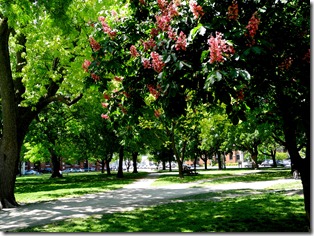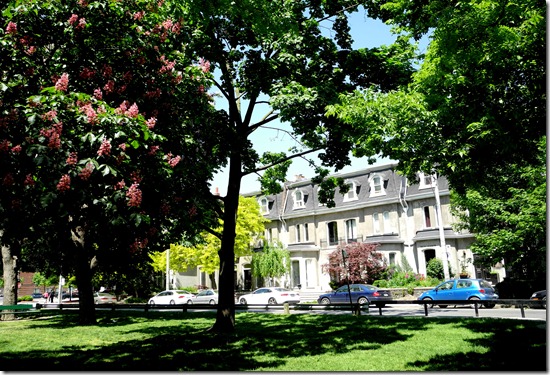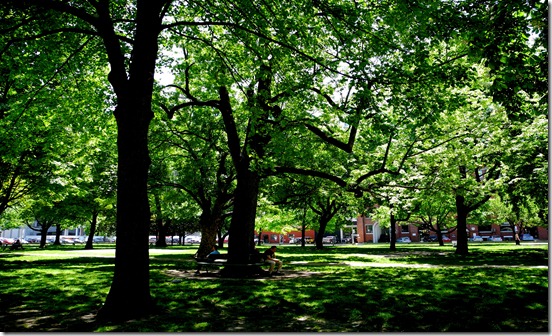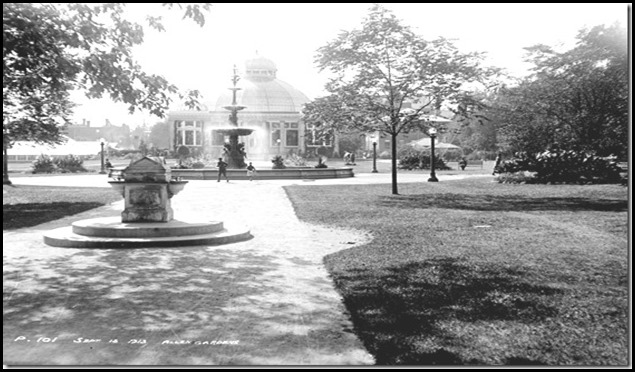The land occupied by Clarence Square was at one time a part of the military reserve attached to Fort York. It was laid out in the 1830s by British engineers to form an important part of a lakeside promenade. During those years, the shoreline of Lake Ontario was on the south side of Front Street, but in the years ahead landfill pushed the lake farther south. Today Clarence Square is isolated from the water, but remains a small charming park, its giant trees providing a quiet retreat in the heart of the city, secluded from the heat of the summer sun.
It is reminiscent of squares created in London, England, during the 1820s. These Regency-style squares possessed wide avenues, with vistas terminating in large spaces that were open to the public. Regent Street in central London is perhaps the best known example. The design was later promoted in Canada by amateur architects such as William Warren Baldwin.
Several sources I consulted stated that Clarence Square was named after Albert Victor, Duke of Clarence (1864-1892) eldest son of Edward VII. However, the name Clarence Square appears on the city maps of the 1850s, before Albert Victor was born. It is more likely that the square received its name from the third son of King George III, Prince William Henry, born in 1765. In 1789, he was granted the title Duke of Clarence and St. Andrew’s. The Duke served in the Royal Navy and became Admiral of the Fleet in 1811.
he Duke of Clarence ascended the throne as King William IV, and died on June 20, 1837. This was the decade when Clarence Square was created by the British troops from Fort York, and it was likely named in his honour. William IV was succeeded on the throne by his niece, Elizabeth Victoria, and the Victorian era was born.
Most sources that record the history of Clarence Square and Wellington Place (now Wellington St. West) offer the opinion that they fell short of their potential and never developed as they were envisioned. However, examining old maps of the city, it seems that this is not truly accurate. Mansions and estates did indeed appear on Wellington Place, lining both sides of the avenue. These grand homes were surrounded by spacious grounds and ornate gardens. Unfortunately, they were destroyed in the twentieth century during the street’s transition from residential to industrial/commercial.
The same is true for Clarence Square. Two of the grandest houses ever constructed in Toronto were situated on the square. On the north side at number 304 was the home of Hugh John Macdonald, son of Sir John A. Macdonald, the nation’s first prime minister.
On the south side of the square at number 303 was the residence of John Gordon, a magnificent mansion in the detailed Italianate style. Gordon was a very wealthy man who had acquired a fortune importing dry goods. He became the president of the Toronto Grey and Bruce Railway. These two houses had sufficient space surrounding them that it was not possible to build more houses on the square. In the centre of the square was an ornate fountain. It was truly a prestigious area during those years.
The extensive land owned by John Gordon, to the south of his residence, was purchased by the railway to allow train tracks to be laid on the south side of Front Street. Within a year or two, because of the noise and soot of the steam engines, Clarence Square was no longer viewed as a desirable residential location, so the house was sold and eventually demolished.
Macdonald’s home, on the north side of the square, disappeared in the late 1870s and in its place row houses was built, in the Second Empire style. The bricks of these historic residences are today hidden beneath grey stucco. Most of them are now offices.
It is a pity that there is no historic plaque to commemorate the history of the square. The plaque that exists in the northwest corner honours Alexander Dunn, who in 1854 was the first Canadian recipient of the Victoria Cross. There is a plan to redevelop this old square, and perhaps this deficiency will then be corrected.
The above information is from the book, “The Villages Within,” short listed for the Toronto Heritage Awards.
Clarence Square, 14 October 1913 – City of Toronto Archives
Row houses from the 1880s on north side of Clarence Square (May, 2012)
Mature trees in Clarence Square today
To view the Home Page for this blog: https://tayloronhistory.com/
To view previous posts about movie houses of Toronto—old and new
https://tayloronhistory.com/2013/10/09/links-to-toronto-old-movie-housestayloronhistory-com/
To view links to other posts placed on this blog about the history of Toronto and its heritage buildings:
https://tayloronhistory.com/2013/10/08/links-to-historic-architecture-of-torontotayloronhistory-com/
Recent publication entitled “Toronto’s Theatres and the Golden Age of the Silver Screen,” by the author of this blog. The publication explores 50 of Toronto’s old theatres and contains over 80 archival photographs of the facades, marquees and interiors of the theatres. It also relates anecdotes and stories from those who experienced these grand old movie houses.
To place an order for this book:
Theatres Included in the Book
Chapter One – The Early Years—Nickelodeons and the First Theatres in Toronto
Theatorium (Red Mill) Theatre—Toronto’s First Movie Experience and First Permanent Movie Theatre, Auditorium (Avenue, PIckford), Colonial Theatre (the Bay), thePhotodome, Revue Theatre, Picture Palace (Royal George), Big Nickel (National, Rio), Madison Theatre (Midtown, Capri, Eden, Bloor Cinema, Bloor Street Hot Docs), Theatre Without a Name (Pastime, Prince Edward, Fox)
Chapter Two – The Great Movie Palaces – The End of the Nickelodeons
Loew’s Yonge Street (Elgin/Winter Garden), Shea’s Hippodrome, The Allen (Tivoli), Pantages (Imperial, Imperial Six, Ed Mirvish), Loew’s Uptown
Chapter Three – Smaller Theatres in the pre-1920s and 1920s
Oakwood, Broadway, Carlton on Parliament Street, Victory on Yonge Street (Embassy, Astor, Showcase, Federal, New Yorker, Panasonic), Allan’s Danforth (Century, Titania, Music Hall), Parkdale, Alhambra (Baronet, Eve), St. Clair, Standard (Strand, Victory, Golden Harvest), Palace, Bedford (Park), Hudson (Mount Pleasant), Belsize (Crest, Regent), Runnymede
Chapter Four – Theatres During the 1930s, the Great Depression
Grant ,Hollywood, Oriole (Cinema, International Cinema), Eglinton, Casino, Radio City, Paramount, Scarboro, Paradise (Eve’s Paradise), State (Bloordale), Colony, Bellevue (Lux, Elektra, Lido), Kingsway, Pylon (Royal, Golden Princess), Metro
Chapter Five – Theatres in the 1940s – The Second World War and the Post-War Years
University, Odeon Fairlawn, Vaughan, Odeon Danforth, Glendale, Odeon Hyland, Nortown, Willow, Downtown, Odeon Carlton, Donlands, Biltmore, Odeon Humber, Town Cinema
Chapter Six – The 1950s Theatres
Savoy (Coronet), Westwood
Chapter Seven – Cineplex and Multi-screen Complexes
Cineplex Eaton Centre, Cineplex Odeon Varsity, Scotiabank Cineplex, Dundas Square Cineplex, The Bell Lightbox (TIFF)

![s0372_ss0052_it0198[1] s0372_ss0052_it0198[1]](https://tayloronhistory.com/wp-content/uploads/2012/06/s0372_ss0052_it01981_thumb.jpg)


![cid_E474E4F9-11FC-42C9-AAAD-1B66D852[2] cid_E474E4F9-11FC-42C9-AAAD-1B66D852[2]](https://tayloronhistory.com/wp-content/uploads/2014/10/cid_e474e4f9-11fc-42c9-aaad-1b66d8522_thumb3.jpg)

